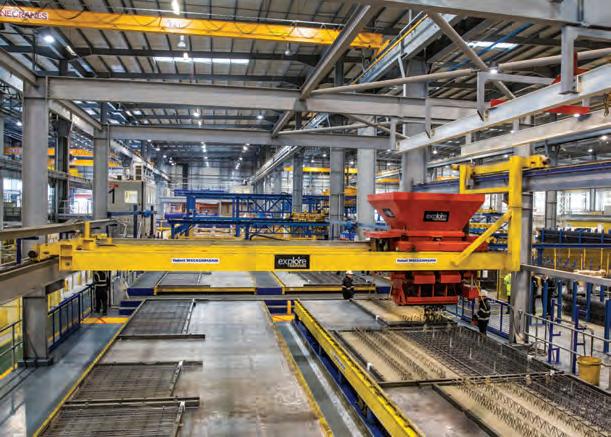
5 minute read
Laing O’Rourk e’s factory target
Will covid-19 accelerate offsite take-up? See p28
Laing O’Rourke wants projects 90% factory-built by 2025
Advertisement
CHAIRMAN RAY O’ROURKE RAISES TARGET AS MANUFACTURING INVESTMENT CONTINUES. BY WILL MANN
Laing O’Rourke is aiming to deliver
90% of construction work on projects inside its factories by 2025.
Currently, the group’s goal is to manufacture 70% of a project’s components offsite, part of its ‘70:60:30’ strategy, which also targets 60% productivity gains and 30% programme improvements through use of design for manufacture and assembly (DfMA).
“We’re now driving towards 80% of our work being factory manufactured,” said head of infrastructure Declan McGeeney. “The Grange hospital in Gwent was in the high 70s. Ray [O’Rourke, group CEO] wants 90% to 95% by 2025.” McGeeney, who revealed that Laing O’Rourke’s manufacturing facilities have been able to operate at full capacity for most of the covid lockdown
Laing O’Rourke’s Centre of Excellence for Modern Construction in Steetley, Nottinghamshire (see p28-32), said several work packages could become more ‘factory-friendly’.
“Structures is one,” he said. “We enter projects later than we would like, which can make it harder to change structural elements. Cladding is not consistent across industry. Finishes tend to be done quite traditionally.
“Getting digital embedded right from tender is key so we can build the project virtually before we reach site.”
McGeeney said he sensed a “marked shift” in attitudes to offsite, with factory environments making it easier to implement social distancing and clients seeing it as a way of de-risking projects.
“We have to plan for any second wave of covid so our projects are not impacted,” he said. “We have more offsite enquiries coming in. Some clients have asked us about redesigning a project to suit DfMA or to prefabricate elements like the structure, the lift shaft, the MEP.
“Even our competitors are asking our businesses about how to embed offsite within their business. Some 50% of turnover at [subsidiary companies] Crown House and Expanded is outside Laing O’Rourke, so we have a chance to shift opinion in the market.” ●
Robotics to play key role in O’Rourke’s next factory
Laing O’Rourke’s planned Advanced Manufacturing Facility, to support its residential business, will feature extensive use of robotics, head of infrastructure Declan McGeeney has told CM.
“The facility will use robotics for 90% of the precision process work,” he said. “We are working with ABB and the University of Sheffield to develop the technology.”
The plant, which will be located next to the group’s Centre of Excellence for Modern Construction in Steetley, Nottinghamshire (formerly Explore Industrial Park), will aim to manufacture 10,000 homes a year. It is currently at “business case stage”, McGeeney said.
“We need to deliver faster, and with fewer people,” he added. “Already we use robotics for cutting pipework at our Crown House factory in Oldbury and at our GRC plant near Doncaster we use 3D printing for mould production.”

#DCS2020
CIOB voices quality fears over planning white paper
CIOB ISSUES QUALITY WARNING AS GOVERNMENT UNVEILS WIDE-RANGING CHANGES TO PLANNING SYSTEM. BY NEIL GERRARD
Eddie Tuttle CIOB xxxxxx xxxxxxxxxxx

Housing secretary Robert Jenrick launched the white paper
The CIOB has voiced fears that the government’s ‘landmark’ planning reforms detailed in the white paper Planning for the Future could harm the quality of new housing developments.
The CIOB warned that there are “clear impacts” on the quality of residential conversions created through permitted development rights (PDRs), with many failing to meet national space standards, lacking amenity space and suffering from low quality design and poor locations.
It added that high volumes of PDRs have wide-ranging impacts on transport, community facilities, play space and green space, and without Section 106 agreements or Community Infrastructure Levy contributions to offset the costs associated with provision of community infrastructure, local authorities are further financially burdened.
The CIOB also voiced fears that PDRs risked jeopardising the public’s trust by creating poor-quality accommodation as standard, in spite of all the work the construction industry has done to reform post-Grenfell.
Eddie Tuttle, director of policy, research and public affairs at the CIOB, said: “The white paper published today highlights the need for reform of the planning system in order to build the homes we desperately need.
“But we are concerned the government’s focus on extending permitted development rights, including the ability to demolish and rebuild commercial and residential buildings on existing sites without a full planning – if implemented without significant safeguards – will lock in more unacceptable standard development, the consequences of which we will live with for generations or must rectify later at greater expense.” ●
Industry has moral obligation over safety, says Hackitt
The construction industry has a “moral obligation” to step up to a different approach on building safety in the wake of the Grenfell Tower disaster.
That’s according to Dame Judith Hackitt, as she presented the Industry Safety Steering Group’s (ISSG) second report on the progress of culture change in the construction sector.
Hackitt, who chairs the ISSG, said she was pleased to “real progress” from some parts of the industry but that it was “equally frustrating” to see others waiting to see what the new regulatory regime will look like before taking action.
SEPTEMBER EVENT WILL FEATURE INDUSTRY-LEADING SPEAKERS AND TOPICAL WEBINAR SESSIONS
This year’s Digital Construction Summit will be a virtual event across 29/30 September.
Originally scheduled for 3 June in the City of London, the event has been rearranged because of the restrictions of the covid-19 pandemic.
The virtual summit will comprise a series of webinar sessions, with topics including: the Building Safety Bill and its digital implications; the role of digital in the built environment’s post-covid recovery; the power of data and its potential for construction; common data environments and interoperability; and digital tools to connect site teams.
Speakers include: Mark Enzer, head of the National Digital Twin Programme and chief technology officer at Mott MacDonald; David Philp, digital impact director at the Construction Innovation Hub and global BIM/MIC consultancy director at Aecom; Neil Thompson, digital construction director at Atkins; and Andrew Gamblen, digital manager at Willmott Dixon.
Event partners are the Centre for Digital Built Britain, the Chartered Institute of Building, Egnyte, i3PT, Atvero and PlanRadar. Construction Manager and BIMplus are media partners.
The summit will feature presentations from industry-leading digital professionals, panel discussions, Q&As and audience interaction.
Over 1,000 professionals from across the built environment with responsibility for driving BIM and digital innovation are expected to attend.
For further information contact: eva@atompublishing.co.uk. www.digitalconstructionsummit.uk











